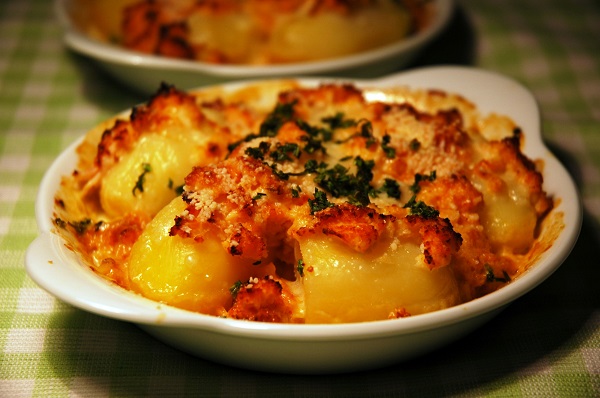Gratin Dishes: C’est Cheese
In common use, the phrase au gratin has become synonymous with a meat, vegetable, or other dish that has cheese in it (macaroni and cheese being the most ubiquitous gratin dish of all).
But that’s not always the case.

The common thread among gratins is a brown crust on top. What differs is how that crust is achieved: breadcrumbs, cheese, or both.
When making a gratin from scratch at home, it’s good to know that béchamel and mornay sauces are most commonly used as the base sauces. Béchamel is the classic white, milk-based sauce—one of the five Mother Sauces of French cuisine. Mornay is a béchamel to which Parmesan and Swiss/Gruyere cheeses are added. Some gratins are made entirely without a creamy sauce and use flavorful oil and seasonings instead.
Origins
Gratin comes from gratter, the French word for grating or scraping. The word gratiné means crust.
Though the origin of gratin dishes is likely the early 19th century, the first mention in print in English dates to the turn of the 20th century.
The characteristic baking and serving vessel for gratin dishes is shallow and either round or oval made of glass, ceramic, copper, or other oven-safe materials.
Variations
While many variations exist, the earliest gratin recipes were for potatoes sliced and layered with other ingredients. The most rustic variation, potatoes gratiné, layers the potatoes in a buttered dish and sprinkled with cheese before browning in the oven or under a broiler.
The most lush example is know in France as Gratin Dauphinois, the same dish we in the U.S. call potatoes au gratin or scalloped potatoes. The original recipe calls for baking the layered potatoes in cream in a pan prepared with butter and garlic. Later variations add cheese for over-the-top richness.
A third variation, called Gratin Savoyard, uses no cream and layers the potatoes with cheese, butter, and stock for the liquid.
Beyond the Basics
The basic recipes for gratin potatoes are blank canvases for fortifying with other ingredients. For example, constructing a gratin dish by layering the potatoes with leftover Easter ham is real post-holiday treat. Sausage, shredded chicken, pulled pork, or just about any other kind of leftover can be successfully combined into a gratin dish.
Likewise, try layering in tomato slices. Or spinach, kale, chard, and other leafy greens add texture, flavor, and nutrients. You can also go so far as to eliminate the potatoes altogether and create vegetable-based gratins—broccoli, cauliflower, and mushroom are outstanding examples.
If using breadcrumbs, try spicing them up with your favorite herbs and spices. Or mix some panko breadcrumbs with crumbled, crispy bacon for a topping that will be a true crowd-pleaser.
And don’t be shy about experimenting with various types of cheese. While Parmesan and Gruyere are typical, any flavorful cheese with good melting qualities will work as well: Fontina, Manchego, Asiago, Cheddar, or Gouda. Such blue cheeses as Roquefort, Gorgonzola, and Stilton are excellent when used alone or in combination with other cheeses.
What’s your favorite way to make a gratin? What’s unique mix-in do you use with potatoes au gratin? What’s your favorite vegetable to prepare au gratin? Do you serve scalloped potatoes alongside your ham for Easter?



Leave Your Response